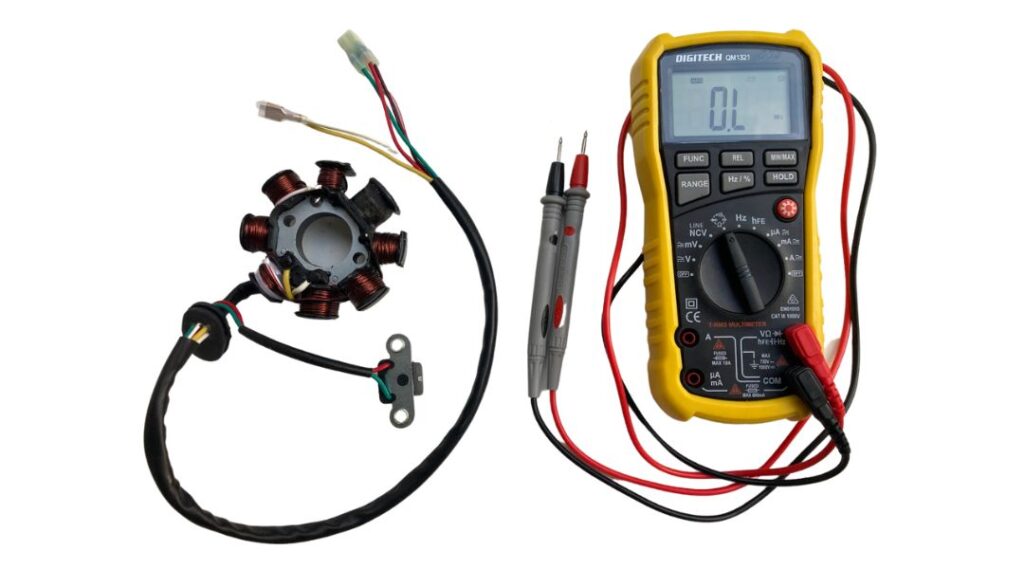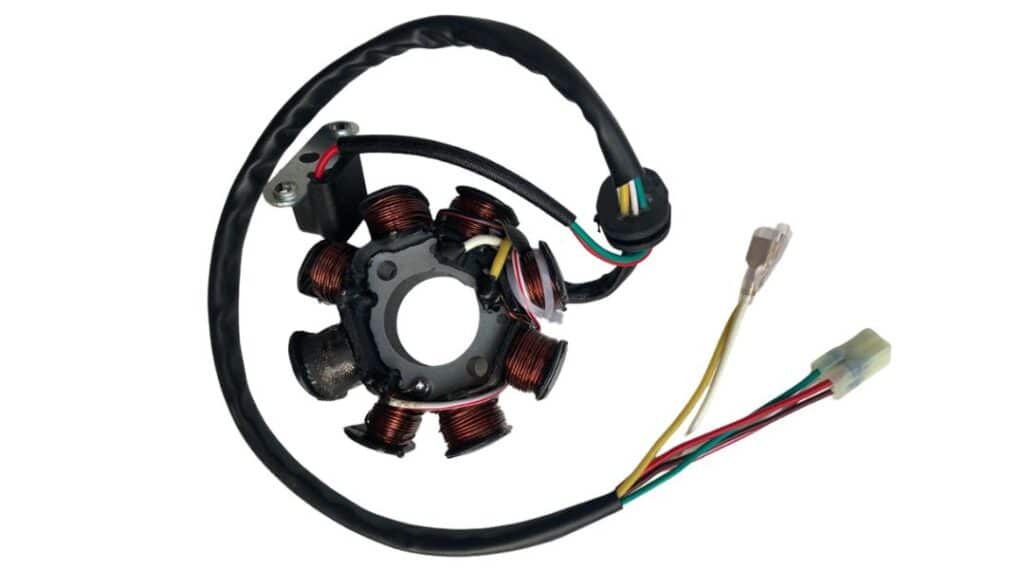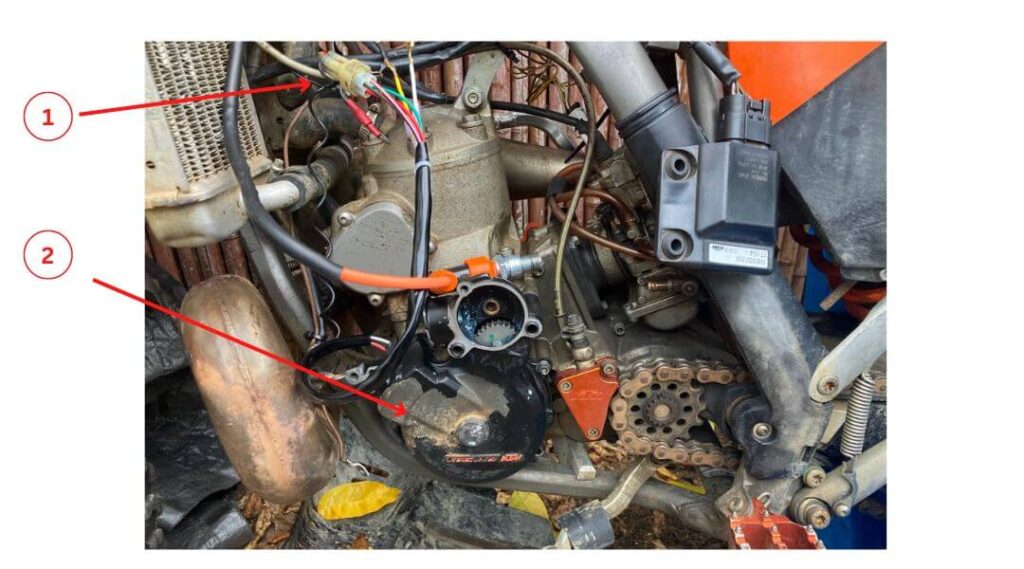The KTM 300 is a solid favorite amongst riders (including myself), and with good reason.
This powerhouse of a machine is fun, fast, light, and generally reliable if kept well-maintained, making it one of the best off-road enduro dirt bikes on the market.
If you’re reading this article you already know that KTM owners love to push their bikes to the limit – why else would you be the proud owner of one of these beautiful enduro beasts? And hey, it’s what they’re built for right?
High revving, dirt and dust, and being at one with the elements unfortunately though are the enemy of your dirt bike stator, the constant heating, cooling, and foreign bits of matter in your stator will eventually cause it to fail.
You can’t do too much about this, and if you take care of your bike your stator should still give you a good run before it packs it in.
So if you’re having trouble starting your dirt bike, or your bike is misfiring or backfiring, you may want to test your stator.
In testing your stator you might find that in fact there is nothing wrong with your stator at all and this can narrow it down to other possible issues such as a faulty battery.
In this article, we’ll run through some stator basics, the tell-tale signs of a bad dirt bike stator, and provide a step-by-step guide on how you can test your KTM 300 dirt bike stator using a multimeter.
What is a dirt bike stator?
A dirt bike stator is a vital part of your motorcycle’s electrical system.
Your dirt bike’s battery (if your bike has one) isn’t able to support these electrical components of your dirt bike on its own.
It relies on the stator to keep it charged and generate alternating current (AC) that is converted to direct current (DC) via your dirt bike’s regulator/rectifier, which can then power the varying electrical components of a motorcycle such as the ignition, fuel injection, lights, fuel pump, starter, and any other electrical functions.
Sometimes referred to as an alternator, the stator is the stationary component that sits within an alternator along with numerous other power-producing components, and generally includes a sensor to tell the spark plug to do its thing.
Because of the size and weight of an alternator, motorcycles use a stator system instead.
Types of KTM 300 dirt bike stators
Generally, a dirt bike stator will either be single-phase or three-phase, with most older models being most likely to use a single-phase stator. The difference between a single-phase or three-phase stator is the amount of power that can be produced.
Single-phase dirt bike stators produce a lower amount of power and are more suited to dirt bikes that don’t have much demand for electrical power, for example, a bike that has no lights and no starter motor.
Three-phase dirt bike stators are more suited to modern dirt bikes that require a higher electrical load to power the ignition, fuel injection, lights, and other modern power-sucking accessories.
A KTM 300 has a single-phase stator due to it needing only a basic electrical supply.
Over the years KTM has changed its ignition systems. Earlier KTM 300s use an SEM ignition system which was prone to issues, leading KTM to change to the Kokusan ignition in 1997.
The stator of your KTM will be different depending on the type of ignition system your dirt bike has and the recommended output of your stator will also depend on this as well.
Bad stator symptoms
Unfortunately, due to the thin copper wiring, the repeated heat cycles (hot and cold then cold again, and again and again…) dirt, junk, and the constant effort to produce electricity, dirt bike stators are prone to wearing out and in need of repair or replacement.
But the first thing is identifying the symptoms of a bad stator so you can narrow down whether or not you need to test your stator.
Some of the most common tell-tale symptoms of a bad stator include;
- your dirt bike won’t start
- your spark is weak or intermittent or getting no spark
- the battery is not getting any charge
- your dirt bike is backfiring or misfiring
How to test motorcycle stator

Things you’ll need to test your KTM 300 Dirt Bike Stator
To test your KTM 300 stator using a multimeter you will need to run a series of static tests. Static simply means that the motor is switched off.
Before you start testing your stator you will need;
- Information about the ignition system specific to your KTM 300 model (you may need to locate your user manual or repair manual to find some of the below information). This should be an SEM or Kokuson ignition (for Kokuson ignition you need to know if it’s a 2k -1, 2, 3, or 4).
- Access to your stator
- A multimeter that can provide at minimum an OHM reading (pick one up cheap from your local hardware store)
It might also be good at this point to carry out a visual inspection of your motorcycle stator. This can save you a bit of time. If there are any obvious signs of damage such as burnt or broken wires, then you can fairly safely say that your stator is the issue.
How to Test a KTM 300 Stator using a multimeter
Testing your KTM 300 stator will help you find out if you have any of the following issues that are causing your dirt bike to misfire or backfire, or not start at all;
- insulation breakdown or broken wires in your stator
- problems with battery output
- problems with the ignition circuit
- issues with the pulse generator (crank position sensor/ pulser coil)
- problems with the exciter coil
When testing a KTM 300 stator, there are generally three components you need to check;
- the pulse generator (pulser coil/crankshaft position sensor) – this tells the spark plug when to fire
- the exciter – the exciter is how the spark plug gets its charge
- the charge coil – this charges the battery and runs the headlights, indicators, and horn while the bike is running
For Kokusan ignition-type KTM 300 dirt bikes you will need to know if your stator is a 2K 1, 2, 3, or 4 system, or an SEM ignition system.
The below static stator tests are for the Kokusan ignition. If you have an SEM ignition skip to the SEM ignition stator test instructions.

To help identify whether you have a Kokusan 2K-1, 2K-2, 2K-3, or 2K-3 use the table below to compare the wire coloring with your dirt bike stator.
Stator Test 1: Check the Pulse Generator/ Pulser Coil (Kokusan Ignition)
To test your pulse generator (also referred to as the pulser coil, pickup coil, trigger coil or crankshaft position sensor), you will need to first get access to your stator.
- Firstly, you will need to make sure your engine is switched off and your stator is cool. The recommended temperature for testing is 68° Fahrenheit or 20° celsius.
- Locate the stator behind the circular stator cover on the left side of the engine.

- Next, you will need to remove the fuel tank. To remove the fuel tank you will need to remove the seat.
- Now remove the fuel line and breather line, and then remove the bolt at the top of the fuel tank.
- After finding the stator cover, find and follow any wiring that comes from the cover. This wire is often wrapped in a black protective covering.
- Next, follow the wire that comes out from behind your stator cover to a plastic connector – this is your stator connector.
- Your next task is to disconnect your stator connector. Make sure you take the time to pay attention to how it disconnects. Care must be taken here not to pull on wires as you may break them – pull firmly on the connector plastic only.

In the image above you can see the stator connect (1) and the stator cover has not ready to be tested.
- Make sure your multimeter is in the OHM (Ω) position
- Place one of the probes of your multimeter into the red terminal, and the other probe into the green terminal (it doesn’t matter which probe you use in which terminal). Make sure none of the wires are touching any other wires.
- You should get a reading of 100 OHMS (Ω) plus or minus 15%. A reading outside of this means you have a problem.
- If your multimeter is reading OL (open line or open loop), it means that you have a break in the wires of your stator and you will need to replace or restore your motorcycle stator.
- Next, place the red probe of your multimeter into the terminals you just tested, and place the other probe (black) on a clean metal part of your bike’s frame, the negative terminal on your battery, or on the motor of your dirt bike.
- For this test you want your multimeter to read OL (Open Line). This means that no electrical current can pass through and the insulation of your stator is in good order.
Stator Test 2: check the exciter
- Again make sure your multimeter is in the OHM (Ω) position
- Place one of the probes of your multimeter into the black/red terminal, and the other probe into the red/white terminal (it doesn’t matter which probe you use in which terminal). Make sure none of the wires are touching any other wires.
- The reading you get will depend if your Kokuson ignition is a 2K -1, 2K-2, 24-3, or 2K-4 system. An OHM (Ω) reading of the below outputs (see table) plus or minus 15% means your exciter is in good condition,
- If your multimeter is reading OL (open line or open loop), it means that you have a break in the wires of your stator and you will need to replace or restore your motorcycle stator.
- Now, as with the previous test, place the red probe of your multimeter into the terminals you just tested, and place the other probe (black) on a clean metal part of your bike’s frame, the negative terminal on your battery, or on the motor of your dirt bike.
- If your multimeter is reading OL (Open Line) the insulation of your stator is in good shape and the stator isn’t grounding itself to the motor and losing electrical output.
Table1: KTM 300 Resistance Reading for Exciter Test
| Kokusan Ignition Type | Resistance Reading |
| 2K -1 | 24 Ω +/- 15% |
| 2K-2 | 24 Ω +/- 15% |
| 2K-3 | 12.7 Ω +/- 15% |
| 2K-4 | 24 Ω +/- 15% |
Stator Test 3: Check the Charge Coil
- Have your multimeter in the OHM (Ω) position
- Again, for testing the charge coil the wires you test will be slightly different depending on what type of stator you have (2K-2, 2K-3, or 2K-4). For a table of the required resistance readings for each stator type see table 2. NOTE: There are no charge coil wires to test on a 2K-1 stator.
Kokuson 2K-2 Stator
- Place one of the probes of your multimeter into the yellow terminal and the other probe to ground (place the probe on any clean metal part of your bike’s frame or on the motor).
- You should get a reading of 0,74 OHMS (Ω) plus or minus 15%
- If your multimeter is reading OL (open line or open loop), it means that you have a break in the wires of your stator and you will need to replace or restore your motorcycle stator.
Kokuson 2K- 3 Stator
- Place one of the probes of your multimeter into the yellow terminal and the other probe to ground (place the probe on any clean metal part of your bike’s frame or on the motor).
- Your reading on your multimeter should be within the range of 0.65 OHMS (Ω) give or take 15%
- Next place one probe of your multimeter into the white terminal, and the other in the yellow terminal
- You should be getting a reading of 0.16 OHMS (Ω) plus or minus 15%
- If your multimeter is reading OL (open line or open loop), it means that you have a break in the wires of your stator and you will need to replace or restore your motorcycle stator.
Kokuson 4K Stator
- Place one probe of your multimeter into one of the yellow terminals, and the other probe into the other yellow terminal
- You should get a reading of 0.65 OHMS (Ω) plus or minus 15%
- If your multimeter is reading OL (open line or open loop), it means that you have a break in the wires of your stator and you will need to replace or restore your motorcycle stator.
Table 2: KTM 300 Charge Coil Resistance Readings
| Kokusan Ignition Type | Wire Color | Resistance Reading |
| 2K-2 | ground to yellow | 0.74 Ω +/- 15% |
| 2K-3 | ground to yellow white to yellow | 0.65 Ω +/- 15% 0.16 Ω +/- 15% |
| 2K-4 | yellow to yellow | 0.65 Ω +/- 15% |
For a handy reference, the table below outlines what full stator elements you will need to test, the wire colors you need to look out for to test, and all of the recommended output resistance readings you will need depending on your dirt bike’s Kokusan ignition system.
Table 3: KTM 300 Stator Testing (Kokosan Stator)
| Ignition Type | What to Measure | Wire Color | Resistance Reading |
| 2K -1 | Crankshaft Position Exciter | red to green black/red to red/white | 100 Ω +/- 15% 24 Ω +/- 15% |
| 2K-2 | Crankshaft position Exciter Charge Coil | red to green black/red to red/white ground to yellow | 100 Ω +/- 15% 24 Ω +/- 15% 0,74 Ω +/- 15% |
| 2K-3 | Crankshaft Position Exciter Charge Coil | red to green black/red to red/white ground to yellow white to yellow | 100 Ω +/- 15% 12.7 Ω +/- 15% 0.65 Ω +/- 15% 0.16 Ω +/- 15% |
| 2K-4 | Crankshaft Position Exciter Charge Coil | red to green black/red to red/white yellow to yellow | 100 Ω +/- 15% 24 Ω +/- 15% 0.65 Ω +/- 15% |
SEM Ignition Stator Test: KTM 300
If your KTM has an SEM ignition system, you need to take the following resistance readings using your multimeter, being sure to test each colored wire with the correct probe of your multimeter, either red for positive (+) or black for negative (-).
It’s important to note here that testing your SEM stator in this way will only uncover critical issues wit your stator.
To troubleshoot non critical issues such as weak ingition sparks or low generator output you will need to use an ignition test bench. Testing your wires/ plug and connections should be your first step.
Table 4: KTM 300 SEM Ignition Stator Tests
| Positive Pole (+) | Negative Pole (-) | Resistance Reading |
| black | red | 1,7 kΩ |
| black | green | 165 Ω +/- 20 Ω |
| green | red | 1,7 kΩ |
| yellow | yellow | 1,0 Ω |
Your dirt bike stator is in good health – Where to from here?
If after running all of the tests you find your stator seems to be in good condition, there may be a few other components of your dirt bike you need to check.
Test the battery
While you’ve got your multimeter out you can do a quick test of the battery.
Use the Volts DC setting of your multimeter and test across the two terminals of your battery. If you get a 12.6 your battery should be in good shape. To be sure there are further tests you can do if you suspect your battery could be the problem.
It might be your regulator/rectifier
The regulator/rectifier is what converts the AC current from the stator to DC current that charges your dirt bike’s battery. If the above stator tests are good but you are still having problems you may have an issue with your regulator/rectifier.
There are further tests you can do at home to test your regulator/ rectifier.
Time to replace your dirt bike stator?
So it looks like your old dirt bike stator is on its last legs and needs to be replaced?
Now, you have a few options. You can either buy a new one or have it repaired/rewound. But, if you’re feeling adventurous and want to save some cash, you can try repairing it yourself.
Just be aware that rewinding a stator is a pretty tricky process that requires a lot of time, patience, and precision. So, weigh your options and choose the best one for you!
Maintaining the life of your dirt bike stator
Apart from not having any fun on your bike, there’s not too much you can do to avoid your stator wearing out over time.
Regular cleaning and maintenance however will give your dirt bike stator a longer life
Taking the simple step of cleaning your dirt bike properly after each ride will help remove dust and debris that’s been thrown up in and around your stator that could lead to wire and insulation breakdown.
When cleaning your bike make sure the engine has completely cooled down as constantly changing temperatures of your stator are one of the factors that will help it to degrade over time.
If you spray cold water on a hot stator it will speed up the degradation of your dirt bike stator (a big no-no).
You got this
I totally get it if you’re feeling a little intimidated about testing your motorcycle stator on your own, but don’t worry – it’s not as scary as it sounds.
With just a cheap multimeter from your local hardware store and a handy guide like this one, you can save yourself some money by diagnosing any issues at home, instead of paying your mechanic to do it for you.
Plus, you’ll learn more about how your KTM 300 works and what signs to look out for in the future.
And let’s be real, having knowledge about your bike equals freedom and independence, so you can go on some epic adventures with your trusty bike. So, don’t be afraid to give it a try.
Happy riding!
FAQS
What causes a stator to fail?
Age is the primary cause of stator failure. Other reasons why your dirt bike stator might start to degrade over time include continual heating and cooling, the introduction of dust and other foreign matter into your stator, and faulty or poor workmanship of the stator itself.
Will a bad stator drain a battery?
Yes. The stator is responsible for charging the battery while your motorcycle is running. If you have a bad stator, your battery is left to charge other components such as lights and ignition on its own and will quickly drain.
Does a motorcycle stator put out AC or DC?
A motorcycle stator produces AC (alternating current). This is then converted to DC (dirct current) via your motorcycle’s regulator/ rectifier.
Can a stator overcharge?
Yes, your dirt bike stator can overcharge. It’s the role of the regulator/rectifier to regulate the alternating current coming from your stator. If your dirt bike stator is overcharging you may have a problem with your regulator/ rectifier.


